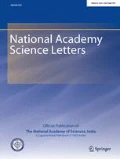Abstract
Valeriana wallichii DC. (Valerianaceae), a threatened medicinal plant of Himalayan region, has individuals showing 3 patterns of sex expression (female, hermaphrodite, and gynomonoecious). In the present study, the effect of floral size reduction on pollination efficiency of female flowers on female plants of Valeriana wallichii has been determined. To check entomophily as the possible mode of pollination, plants growing in nature are monitored whether or not the flowers are visited by some insects. Apis dorsata and Apis cerana are observed to be the main pollinators of this species. Female plants receive less pollinator service as compared to hermaphrodite plants. Reduced floral size in females offers more number of stigmas to get pollinated in a single visit as greater number of flowers get in contact with the visiting insect. The time of stigma receptivity also varies in female and hermaphrodite flowers. In females, it remains receptive for longer duration. Further, the pollen load on stigmata of open pollinated hermaphrodite as well as female flowers is studied. It is experimentally demonstrated that at the end of the season, the amount of pollen load is lesser in females as compared to hermaphrodites. Reproductive output of both types of individuals is estimated, and seed germination experiments are performed. Reproductive output and seed germination are more in females.


References
Brys R, Jacquemyn H, Hermy M (2008) Pollination efficiency and reproductive patterns in relation to local plant density, population size and floral display in the rewarding Listera ovata (Orchidaceae). Bot J Linnean Soc 157:713–721
Chen M, Zho XY, Zuo XA (2018) Pollinator activity and pollination success of Medicago sativa L. in a natural and a managed population. Ecol Evo 8:9007–9016
Grindeland JM, Sletvold N, Ims AR (2005) Effects of floral display and plant density on pollination visitation rate in a natural population of Digitalis purpurea. Func Ecol 19:383–390
Kaczorowski RL, Seliger AR, Gaskett AC, Wigsten SK, Raguso RA (2012) Corolla shape vs. size in flower choice by a nocturnal hawkmoth pollinator. Func Ecol 26:577–587
Ashman T, Knight TM, Steets JA, Amarasekare P, Burd M, Campbell DR, Dudash MR, Johnston MO, Mazer SJ, Mitchell RJ, Morgan MT, Wilson WG (2004) Pollen limitation of plant reproduction: ecological and evolutionary causes and consequences. Ecol 85:2408–2421
Suetsugu K, Fukushima S, Naito RS, Kawakita A (2015) Pollination system and the effect of inflorescence size on fruit set in the deceptive orchid Cephalanthera falcate. J Plant Research 128:585–594
Rather AM, Nawachoo IA, Ganie A, Wani AA (2012) Bioactive compounds and medicinal properties of Valeriana jatamansi jones-a review. Life Sci J 9:847–850
Khajuria A, Verma S, Sharma P (2011) Stylar movement in Valeriana wallichii DC.—a contrivance for reproductive assurance and species survival. Curr Sci 100:1143–1144
Shivanna and Rangaswamy (1992) Pollen biology: a laboratory manual. Narosa Publishing House, New Delhi
Williams CF, Kuchenreuther MA, Drew A (2000) Floral dimorphism, pollination and self-fertilization in gynodioecious Geranium richardsonii (Geraniaceae). Am J Bot 87:661–669
Lloyd DG (1975) The maintenance of gynodioecy and androdioecy in angiosperms. Genetica 45:325–339
Acknowledgements
The authors are thankful to Department of Biotechnology, Govt. of India, for funding this research through a project on studying the reproductive biology of threatened plants. Thanks are also due to University authorities of Baba Ghulam Shah Badshah University, Rajouri, for providing necessary facilities.
Funding
Funding was provided from Department of Biotechnology, Govt. of India.
Author information
Authors and Affiliations
Corresponding author
Ethics declarations
Conflict of interest
The authors declare they have no conflict of interest in relation to this article.
Additional information
Publisher's Note
Springer Nature remains neutral with regard to jurisdictional claims in published maps and institutional affiliations.
Statement
Keeping in view the variable sex expression of Valeriana wallichii in natural habitats, a study on its pollination biology was planned. Less pollinator visits limit fruit and seed production, but in this species reduced floral size of female flowers offers more number of stigmas to get pollinated in a single visit. Moreover, stigma remains receptive for longer duration in female flowers.
Rights and permissions
About this article
Cite this article
Kumari, P., Khajuria, A., Wani, I.A. et al. Effect of Floral Size Reduction on Pollination and Reproductive Efficiency of Female Flowers of Valeriana wallichii, a Threatened Medicinal Plant. Natl. Acad. Sci. Lett. 44, 75–79 (2021). https://doi.org/10.1007/s40009-020-00954-8
Received:
Revised:
Accepted:
Published:
Issue Date:
DOI: https://doi.org/10.1007/s40009-020-00954-8

